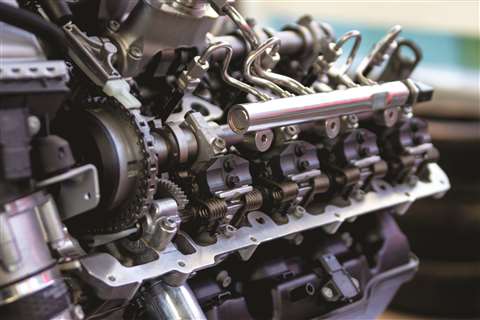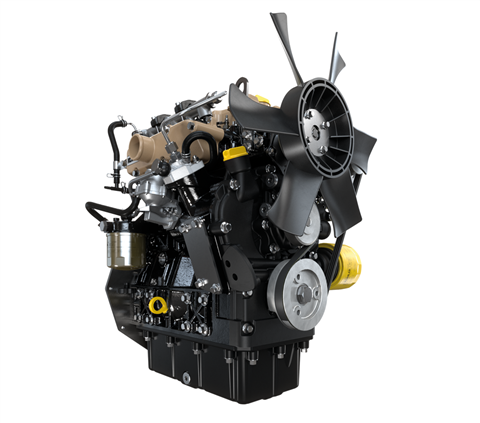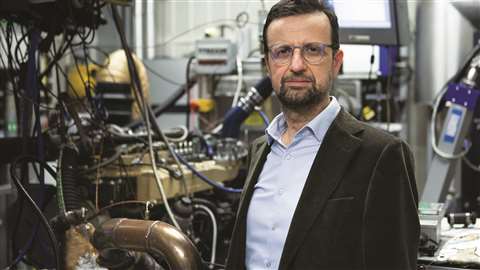Is hydrogen the future of construction equipment?
22 November 2022
Luigi Arnone, engineering director of diesel engines at Kohler, discusses the development of diesel engines and the position of hydrogen in the future of off-highway engine design
How much longer does Kohler expect diesel machines to be at the heart of construction projects?
 Photo: AdobeStock
Photo: AdobeStock
Diesel engines will play a key role in the construction industry for a long time to come. More generally, the industry will continue to need internal combustion engines for applications that have a high demand for mechanical power and energy.
We believe that the future will not have a single direction but will instead see a wide range of solutions capable of meeting all the requirements of a wide variety of machines: internal combustion engines, hybrid (thermal-electric) power units, and all-electric power units will coexist together.
The adoption of one or the other technology already depends on multiple factors, the machine and its duty cycle, the market, the environment in which the machine will work, and its requirements.
Looking at construction machinery, today we find an increase in machines equipped with electric power units in the small size range. This is an obvious trend.
In the case of machines with limited power demand, limited range, and working in urban environments where there is the availability of electricity for charging, they can benefit from adopting electric power units.
Larger machines on the other hand continue to rely mostly on diesel engines. I believe the reasons for this lie in the basic characteristics of internal combustion engine technology, which offer clear advantages.
I am referring, for example, to a large amount of energy that can be stored in the fuel tank, which ultimately does not limit the range of the vehicle or significantly affect the layout and mass. Refuelling is also very fast and does not affect the uptime of the machine.
Not to mention that the cost of diesel engines is significantly lower than other technologies.
What is the main focus of diesel engine development at the moment?
In a few words, I would say that the main goals of diesel engine development are to maximise value for OEMs and end users while at the same time reducing environmental impact.
This is achieved by identifying, selecting and integrating the proper new technologies into the product through R&D activities.
Specifically, one of the key targets in the development is to maximize machine productivity and uptime, and to minimize the total costs of ownership, thus allowing the end-user to take full advantage of their machine.
 Kohler’s new KSD 1403 engine. (Photo: Kohler)
Kohler’s new KSD 1403 engine. (Photo: Kohler)
To achieve these targets, the engine manufacturer moves through several paths, starting from the design concept phase of the new engine.
An approach to down-size (or, as we say, right-size) the engine is one of the key factors to improving engine performance and, consequently, machine productivity.
I am referring, of course, to the power and torque outputs, and to the ability of the engine to promptly respond readily to the sudden load and speed change demands typical of many construction machines.
Right-sizing is also beneficial for controlling fuel consumption, as well as for many other engine characteristics. Minimising fluid consumption (fuel, lubricant, DEF – in case of engines with SCR after treatment) is a key factor in controlling machine operating costs.
To this end, service and maintenance costs are also extremely important: the engine layout should be designed to facilitate service operations (advanced service tools should also be considered for this purpose); in parallel, features to increase service intervals should be considered in the engine design.
Last but not least, the environmental footprint is another key target of diesel engine development. We at Kohler Engines, in line with the Group’s identity, are working toward a more sustainable future.
Are diesel engines now being designed, with a view to switching them to hydrogen fuel engines in the future?
The use of hydrogen fuel in internal combustion engines is, in our view, one of the most attractive options we have for minimising the environmental footprint of powertrains and, at the same time, continuing to exploit the advantages of engines over other systems.
We believe that the new fuel space plays a fundamental role in reducing the carbon footprint and, in general, the environmental impact of power systems.
 Luigi Arnone, engineering director of diesel engines at Kohler. (Photo: Kohler)
Luigi Arnone, engineering director of diesel engines at Kohler. (Photo: Kohler)
I am referring, for instance, to the fuels that have been appearing on the market in recent years, such as HVO, GTL and so on, whose use allows some reduction in pollutant emissions.
However, the main advantage of these fuels is that they generate a reduction of the overall CO2 in the environment compared to fossil fuels of up to 90%. This includes the CO2 required to produce the fuel itself.
Our diesel engines are designed to use HVO, mixed with diesel oil or pure, without any modifications to the engine itself or the vehicle’s fuel tank and fuel system.
In other words, by simply fuelling the machine with HVO instead of diesel, a drastic and sudden reduction in carbon dioxide is achieved. Again, this is a “low-hanging fruit,” a technology available today that requires no modifications to the engine or machine.
Looking at the medium term, hydrogen is a great technology, and it is taken into proper consideration in the development of new engines.
As for engines, specific injectors and other components are under development. However, engines will not undergo substantial changes in overall layout, size and weight.
The hydrogen engine, in other words, is a drop-in solution to replace the diesel engine: same performance and no relevant changes to the installation in machines – if we consider only the engine.
What are the advantages of hydrogen?
In addition to the obvious CO2 advantage – which is hardly present in the engine exhaust – the adoption of a proper after-treatment system can bring all pollutant emissions to negligible values.
This is a really important point: the adoption of hydrogen makes the internal combustion engine a near-zero-emission power generation system!
Along with this, the advantages of the engine over, say, a fuel cell-based powertrain should be considered: higher power density, no need for batteries, lower cost, and greater technological maturity.
We see two major challenges with hydrogen. The first is field availability: how can hydrogen be made available for refuelling vehicles?
Several options are being considered, from distribution networks to local micro-production plants and refuelling stations.
The second is in-vehicle storage: hydrogen is stored in high-pressure tanks whose impact on the vehicle, in terms of volume, is not negligible.
Research is progressing on the adoption of special materials able to absorb and desorb hydrogen; but there’s no solid technology yet.
In summary, the challenges are there, but we believe that the hydrogen-fuelled engine is one of the most interesting technical solutions for the future of construction machinery.
MAGAZINE
NEWSLETTER
CONNECT WITH THE TEAM





